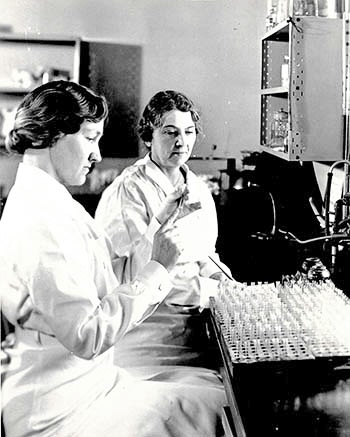Margaret J. Pittman, Ph.D. (1901-1995)
In 1957, Dr. Margaret Pittman became the first woman named chief of a National Institutes of Health (NIH) laboratory, the Laboratory of Bacterial Products, a post she held until her retirement in 1971.
Margaret Pittman grew up in Prairie Grove, Arkansas and credited her interest in science to her father who was a physician. She graduated magna cum laude in 1923 from Hendrix College (Arkansas), majoring in mathematics and biology.
Dr. Pittman taught at Galloway College (Atlanta) and then attended the University of Chicago for a masters and Ph.D. in bacteriology.
In 1928, Dr. Pittman began working at the Rockefeller Institute of Medical Research (New York) with Dr. Rufus Cole on whether Hemophilus influenza caused influenza (it does not). Developing a vaccine against meningitis caused by a strain of H. influenza earned her an international scientific reputation before the age of 30.
Dr. Pittman, at left, and Dr. Sadie L. Carlin reading an agglutination reaction, part of the test for potency of anti-meningitis serum (1937) National Museum of American History
During World War II, Dr. Pittman investigated the safety of blood and blood products, discovering and eliminating the cause of fever and death from plasma infusions.
In 1944, she developed a new assay to test the potency of the pertussis vaccine, under the direction of Dr. Milton Veldee, Director of the Biologics Control Laboratory at the time.
After World War II, Dr. Pittman continued to work with other bacterial vaccines, including cholera, where she worked with the Southeast Asia Treaty Organization (SEATO). She was also instrumental in assessing the efficacy of and establish national and international standards for the production of the yellow fever vaccine and the typhoid vaccine.
Dr. Pittman with her ‘right hand,’ technician James F. Marshall, in 1971 (caption provided by Dr. Pittman) “Margaret Pittman: Down to a 40-hour work-week,” Gail McBride, Medicine on the Midway, Spring 1987, pp. 3-8.
Dr. Pittman worked in Building 29, Fourth Floor from 1960 to 1971.
Publications:
- “Immunization against neonatal tetanus in New Guinea” by Michael F. Barile, M. Carolyn Hardegree, and Margaret Pittman. Bulletin, World Health Organization (1970). https://www.ncbi.nlm.nih.gov/pmc/articles/PMC2427675/?page=1.
- “Pertussis Vaccine Testing for Freedom-From-Toxicity” by Margaret Pittman and Claire B. Cox in Applied Microbiology (1965). https://www.ncbi.nlm.nih.gov/pmc/articles/PMC1058270/.
- “Laboratory Assays of Different Types of Field Trial Typhoid Vaccines and Relationship to Efficacy in Man” by Margaret Pittman and Howard J. Bohner in the Journal of Bacteriology (1966). https://www.ncbi.nlm.nih.gov/pmc/articles/PMC316112/.
- “The Pyrogenicity of Bacterial Contaminants Found in Biologic Products” by Thomas F. Probey and Margaret Pittman in the Journal of Bacteriology (1945). https://www.ncbi.nlm.nih.gov/pmc/articles/PMC374156/.
In Her Own Words:
- “A Life with Biological Products” by Margaret Pittman in Annual Reviews: Microbiology (1990). https://www.annualreviews.org/doi/pdf/10.1146/annurev.mi.44.100190.000245.
More Resources:
- Pittman, Margaret - NIH Women Scientists
- O'Hern, Elizabeth Moot. Profiles of Pioneer Women Scientists. Washington, D.C.: Acropolis Books, Ltd., 1985. (available in hard copy only)
- "Reflections on 50 Years at NIH" an Interview with Margaret Pittman by Dr. Victoria A. Harden in the first issue of the NIH Alumni Association Magazine, Spring 1989.



